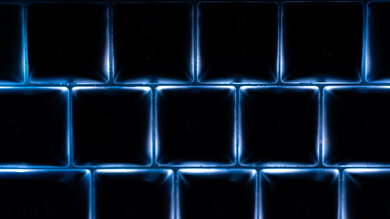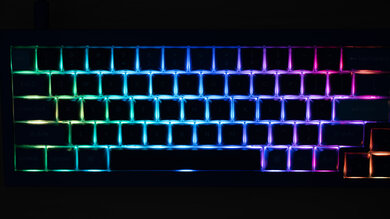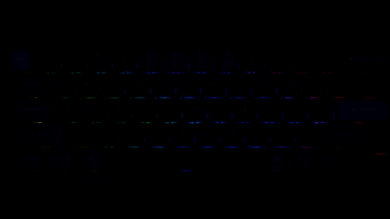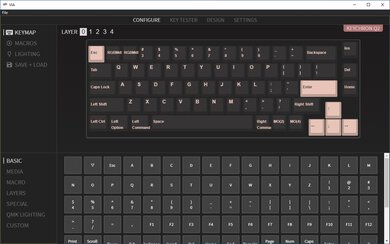The Keychron Q2 is a 65% compact wired keyboard that feels very similar to the Keychron Q1, but it's smaller and has upgraded PBT keycaps with a different shape. It's highly customizable and comes in a barebones version so that you can install your own switches and keycaps. There's also a variant that comes with a programmable knob. We tested the fully-assembled version with tactile Gateron G Pro Brown switches, which feel light to type on and are very quiet. Unlike most other Keychron boards, there's customization software available, so each key is macro-programmable, and the customization software is available on Windows and macOS, as well as Linux. Unfortunately, it doesn't come with a wrist rest, but you can buy one separately to improve comfort. While its PBT keycaps are a great upgrade from the usual ABS keycaps found on Keychron units, they're not translucent, so the backlighting doesn't shine through the legends. Also, while its latency is decently low, it's not as low as other gaming-oriented options.
Our Verdict
The Keychron Q2 is an impressive gaming keyboard. It feels incredibly well-built and has customizable RGB backlighting. Though the pre-travel distance on our Gateron G Pro Brown switches is fairly long, they still provide a light typing experience, though you may prefer other switches. Thankfully, since it's a hot-swappable board, you can install whichever switches you like. Also, its latency is decently low, and all of its keys are macro-programmable through the companion software, which is available on Windows, macOS, and Linux.
-
Feels incredibly well-built.
-
All keys are macro-programmable.
-
Companion software available on Windows, macOS, and Linux.
-
No wrist rest included.
-
Keycaps aren't translucent.
The Keychron Q2 isn't designed for mobile devices or tablets since it's a wired-only keyboard. However, it uses a USB-C to USB-C connection, so you can plug it into a device that has a USB-C port, and all keys, including hotkeys, will work.
The Keychron Q2 is a very good keyboard for office use. It feels very well-built and sturdy. The Gateron G Pro Brown switches on our unit provide nice tactile feedback, and the overall typing quality is excellent, thanks to the PBT keycaps. Also, the sound-absorbing foam in the board helps reduce noise, so you shouldn't disturb others around you, though the noise levels will be different with different switches. The board is also fully compatible with both Windows and macOS. Unfortunately, it's a high-profile board that lacks a wrist rest, but you can buy one separately.
-
Feels incredibly well-built.
-
All keys are macro-programmable.
-
Companion software available on Windows, macOS, and Linux.
-
No wrist rest included.
The Keychron Q2 is a great keyboard for programming. The Gateron G Pro Brown switches on our unit help to provide an excellent, light typing experience, and the board itself feels incredibly well-built. All its keys are macro-programmable through the companion software, available on Windows, macOS, and Linux. Unfortunately, since it's a wired-only board, it's not a good choice for multi-device setups as you can't connect it wirelessly. Also, it doesn't come with a wrist rest, but you can purchase one separately to improve comfort.
-
Feels incredibly well-built.
-
All keys are macro-programmable.
-
Companion software available on Windows, macOS, and Linux.
-
No wrist rest included.
-
Wired-only board.
The Keychron Q2 is a poor keyboard for a home theater PC setup, as it isn't designed for this use. It's wired-only, so you'd have to run the cable from your seating area to the PC. Also, it lacks a trackpad, so you'd require extra devices to help you navigate the screen.
-
Feels incredibly well-built.
-
No wrist rest included.
-
Wired-only board.
-
Keycaps aren't translucent.
- 8.5 Gaming
- 3.7 Mobile/Tablet
- 7.8 Office
- 8.1 Programming
- 5.1 Entertainment / HTPC
Changelog
- Updated Sep 23, 2022: Added in a comparison to the recently reviewed Keychron Q8.
- Updated Sep 02, 2022: Updated the "White Shot" image to better reflect real-life color mixing observations. This result has changed accordingly. Also updated Linux compatibility as this keyboard is fully compatible with this system. The review now shows these changes.
- Updated Feb 03, 2022: Review published.
- Updated Jan 31, 2022: Early access published.
- Updated Jan 26, 2022: Our testers have started testing this product.
Check Price
Differences Between Sizes And Variants
We tested the fully-assembled Keychron Q2 in the Navy Blue colorway with Gateron G Pro Brown switches. There are two other colorways: Carbon Black and Silver Grey. You can also get this keyboard with linear Gateron G Pro Red or clicky Gateron G Pro Blue switches. There's also a variant that includes a programmable rotary knob in the top right corner. Also, you can purchase this keyboard barebones, which means it doesn't come with switches and keycaps, so you have to purchase and install them yourself. Though we normally include a label photo, our unit doesn't have one.
Compared To Other Keyboards
The Keychron Q2 is a compact, wired-only keyboard designed for gaming use. Like some other Keychron offerings, it's hot-swappable and fully customizable. Though it feels similar to the Keychron Q1, the Q2 lacks a row of function keys at the top, but it has upgraded PBT keycaps and an extra gasket added to increase the flexibility and dampen the sound further. While its latency is decent, some gamers may prefer an option with lower latency.
For more options, check out our recommendations for the best gaming keyboards, the best quiet keyboards, and the best Keychron keyboards.
The Keychron Q1 and the Keychron Q2 are both compact, hot-swappable keyboards, but the Q2 has some noticeable differences. The Q2 doesn't have a row of function keys at the top, and its keycaps are made of a high-quality doubleshot PBT rather than ABS, so it feels better to type on. The Q2 also has an extra gasket added inside the board to increase the flexibility during typing. On the other hand, the Q1 has a lower fixed incline, so you won't have to stretch your wrists as much. Also, its latency is marginally lower.
The Keychron Q2 and the Keychron Q3 are very similar wired-only, hot-swappable keyboards, but they have slight differences. The Q2 is a 65% compact keyboard, so it lacks a row of dedicated function keys, and it's missing some buttons from the navigational cluster. On the other hand, the Q3 is a TKL size, meaning it has a full navigational cluster and a row of dedicated function keys. Both keyboards perform nearly identically, so it's a matter of personal preference on what size you want.
The Keychron Q2 and the GLORIOUS GMMK PRO are both wired mechanical keyboards with hot-swappable switches, meaning you can swap out the stock switches for any compatible switch type. The GMMK PRO is a 75% form factor, meaning it has a row of function keys at the top and has a programmable knob. It also has significantly better latency. On the other hand, the Q2 is more compact with 65% form factor, and the programmable knob is only on certain variants. Also, the Q2 has software fully compatible with both Windows and macOS, while the GMMK PRO's software only works on Windows.
The Keychron K8 and the Keychron Q2 are mechanical keyboards with different features. The K8 is a TKL board with a wireless connection, while the Q2 is a compact 65% wired-only board. Unlike most Keychron offerings, the Q2 has companion software to remap keys, and since it's wired, it has a switch at the top to toggle between Windows and macOS modes.
The Corsair K100 RGB and the Keychron Q2 are both wired-only mechanical gaming keyboards, but the Corsair performs significantly better overall. The Corsair has much better latency, translucent keycaps, and it has incline settings and comes with a detachable wrist rest. It's a full-size keyboard and has dedicated media keys, key-locking features, and a USB passthrough. On the other hand, the Keychron is a compact board that's hot-swappable, meaning you can customize its switches and keycaps. Also, the Keychron feels slightly better built thanks to its aluminum chassis, and it's fully compatible with macOS.
The Razer Huntsman and the Keychron Q2 are two very different mechanical keyboards. The Razer is a full-size keyboard designed for gaming use, so it has significantly better latency and uses Razer Optical switches, which have a shorter pre-travel distance. On the other hand, the Keychron is a compact 65% board better suited to office use. It has PBT keycaps rather than ABS, so it feels more premium to type on, and its software is compatible with both Windows and macOS, while the Razer's software is only compatible with Windows.
The Corsair K55 RGB Pro and the Keychron Q2 are both wired-only gaming keyboards, but they have significant differences. The Keychron is a compact mechanical keyboard with individually lit keys and a much better build quality. It's hot-swappable, meaning you can change out any of the switches. On the other hand, the Corsair is a full-size keyboard that uses rubber dome switches. It has better ergonomics thanks to its incline settings and included wrist rest, and its latency is significantly lower.
The Keychron Q2 and the Keychron Q7 are nearly identical keyboards from Keychron's Q-series. This series features keyboards with a high build quality featuring premium materials like an all-aluminum chassis and specialized PBT keycaps. The major difference between these two boards is their size: the Q2 lacks a few of the navigational cluster buttons found on the Q7. The Q2 has a variant with a programmable knob in the top right corner, while the Q7 is only available knobless.
Test Results
This is a 65% compact board, but if you'd prefer something slightly larger that keeps the navigational cluster and dedicated function row, check out the Keychron Q3. Alternatively, if you want something even smaller, the Keychron Q4 eliminates the arrow keys and buttons on the right side for an even smaller form factor.
The Keychron Q2 feels incredibly well-built. Both the aluminum chassis and the metal base plate feel very solid and don't flex. The keycaps are doubleshot PBT, which is an upgrade as most other Keychron boards come with ABS keycaps. The PBT keycaps feel very good to type on, and they offer an improved keycap design, which have the height of an OEM keycap with the rounded tops of an SA keycap to better cradle your fingertips. However, the keys have a slight wobble to them, especially the larger keys, but this isn't noticeable while typing. Also, there are rubber feet on the bottom that do a good job of keeping the board in place, but the weight of the board also helps. Though this board feels very similar to the Keychron Q1, the Q2 added an extra gasket for a double-gasket design to offer better sound absorption and feel when you bottom keys out.
This board is also available in a barebones format, which you can build and customize yourself with your own switches and keycaps. While we bought our unit fully assembled, you can see a detailed shot of our unit with some switches and keycaps removed here.
The Keychron Q2 has mediocre ergonomics. It's a straight, high-profile board with no incline settings, which can get uncomfortable during long periods of use as your wrists have to bend a little more upwards. It doesn't include a wrist rest, but fortunately, Keychron sells them separately, which should improve comfort. If you're interested in a similar customizable board with improved ergonomics, check out the Keychron Q8.
The Keychron Q2 has remarkable backlighting. Each key is individually lit, and you can change the brightness settings or lighting effects using hotkeys directly on the board. However, the light doesn't shine through the keycaps, so the legends are difficult to see in a dark room. It's important to note that this issue is only with the included keycaps, and you can replace the keycaps. The color mixing is poor since the white backlighting has a strong blue tone to it that's unrelated to the keycap color.
The Keychron Q2 comes with a braided USB-C to USB-C cable, but it includes a USB-C to USB-A adapter, which we included in our length measurement. Though the cable does retain kinks from its packaging, its quality is nice overall.
Like other wired Keychron keyboards that we've tested, the Keychron Q2 has a switch on the top left side to toggle between Windows and macOS modes. The included user documentation contains a list of various hotkeys you can use as Media hotkeys, as well as hotkeys to customize the RGB lighting effects.
There's a variant that has a knob in the top right corner that can be programmed to perform media controls or macros.
The Keychron Q2 comes in your choice of tactile Gateron G Pro Brown, clicky Gateron G Pro Blue, or linear Gateron G Pro Red switches, all of which come pre-lubed. We tested the Gateron G Pro Brown switches, which feel light to type on and provide nice tactile feedback. The pre-travel distance is long, which helps prevent accidental keystrokes from being registered, but it may not feel ideal for some gamers. Also, since this board is hot-swappable, you can install any switch that you want.
The Keychron Q2 provides an excellent typing experience. Our unit has Gateron G Pro Brown switches, which have nice tactile feedback and feel light to type on. Thanks to the double-gasket design, there's a more flexible typing feel that's noticeable when you bottom out the keys or apply a bit of pressure. There's also sound-absorbing foam that helps keep the board quiet. Unlike the Keychron Q1, this keyboard has doubleshot PBT keycaps with an SA-style, so they're rounder at the top and more concave to help guide your fingers into place. The PBT material also feels less slippery than the ABS keycaps on the Q1. While most keys feel stable, there's a slight wobble in the larger keys, especially the spacebar. Unfortunately, the board's high profile makes it uncomfortable to type on for a long period without a wrist rest, but Keychron sells them separately. You can also get this board in linear Gateron G Pro Red or clicky Gateron G Pro Blue switches, or you can swap out the switches for any that you prefer as it's hot-swappable. However, your typing experience will be different from ours with different switches.
The Gateron G Pro Brown switches on the Keychron Q2 unit are very quiet, thanks to the sound-absorbing foam inside the board. If you get linear or clicky switches, the typing noise level will change.
The Keychron Q2 has decently low latency, and it should feel responsive enough for casual gaming or daily use. However, some gamers may prefer a lower option for fast-paced or competitive gaming.
The Keychron Q2 is compatible with the VIA software; however, you'll need to download the keymap .json file from the Keychron Q2 product page on Keychron's website before you can begin customizing. With the VIA software, you can remap keys, set macros, and set profiles. There are five layers of key customization: two for macOS, two for Windows, and one for function keys. You can access the second layer of commands in either mode by holding the Fn key and pressing the button you programmed. Also, this keyboard is compatible with QMK firmware.
The Keychron Q2 has fantastic compatibility. As long as you set the switch to the proper operating system, all keys will work as intended on Windows, macOS, and Linux. The VIA software is available on all three operating systems.
Note: While our current methodology automatically counts wired-only keyboards as incompatible with mobile devices, since this keyboard uses a USB-C to USB-C connection, we tested it on an Android device with a USB-C port. We found that all keys worked, including the hotkeys.
Comments
Keychron Q2: Main Discussion
Let us know why you want us to review the product here, or encourage others to vote for this product.
This product has been merged with Keychron Q2 Swappable RGB Backlight Brown Switch Knob. Follow the discussion here.


































